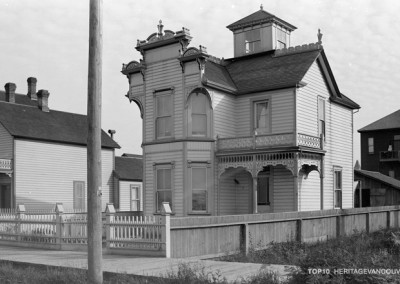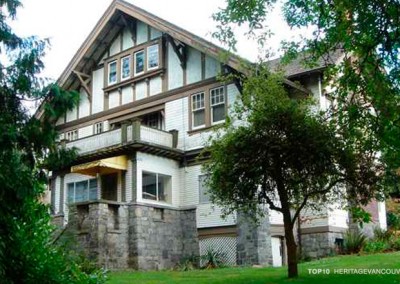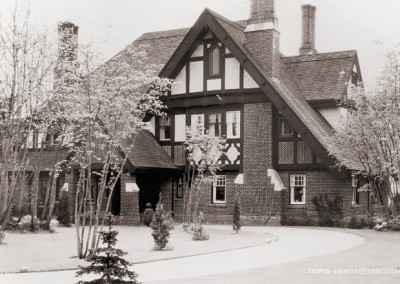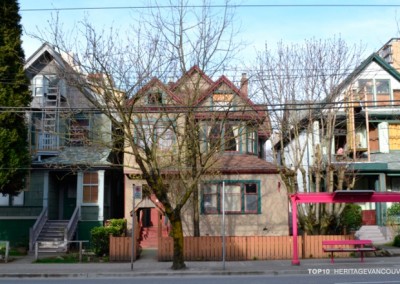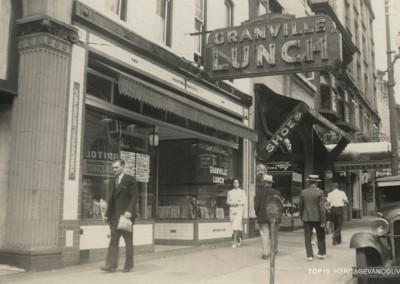In 2012, the City of Vancouver began the development of a new Grandview Woodlands Community Plan that will impact the future of the Grandview neighbourhood’s heritage resources. Heritage Vancouver is involved with the Plan and will participate in charting a direction that preserves Grandview’s heritage character.
The historic character of Grandview is potentially threatened if many of its heritage buildings, particularly those not listed on the City of Vancouver’s Heritage Register, are demolished to make way for new housing. There are also many other aspects of neighbourhood heritage character, such as early commercial buildings and majestic street trees, which could be lost over time if there is no plan for their conservation.
Threat
What is the threat to the Grandview Neighbourhood?
Since there is little land remaining in the city that is undeveloped, the majority of new population growth will be taking place in existing neighbourhoods through infill and intensification. If population growth rates meet current projections, there will have to be serious consideration given to how — not if — densification occurs. As the City’s land values rise, there is increasing pressure to develop sites on the East Side of Vancouver.
Grandview is one of Vancouver’s oldest historic neighbourhoods, with many consistent streetscapes of older houses and commercial buildings, few of which are on the City of Vancouver’s Heritage Register. While individual owners continue to work to upgrade their houses within broad heritage principles, builders and developers have set a trend of erecting front-back duplexes on 33-foot lots in a generic “heritage” style that can erode overall neighbourhood character.
Historic resources that are not listed on the Vancouver Heritage Register are threatened, as they are not eligible for the creative tools, relaxations and bonuses offered for Register resources. Unsympathetic zoning allows unchecked demolition of houses not on the Register, leading to generic replacement buildings. Some historic houses that are not on the Register sit on multiple lots, which could be attractive to developers and very difficult to retain. There are, for example, several historic houses, such as the Ball and Foster houses at Kitchener and Lakewood that sit on multiple lots, which could be attractive to developers and difficult to retain especially since they aren’t listed on the heritage register.
Commercial Drive – our best surviving early commercial streetscape outside of the downtown core – has no specific heritage protection, and could be threatened with the kind of densification being seen on Vancouver’s other arterial corridors.
A key issue is that the current planning process does not make any provision for the addition of historic resources to the Heritage Register. There is a serious disconnect between the City’s community planning process and the desire to conserve heritage resources, as promised funds have consistently failed to materialize for the proposed update of the Heritage Register.
In addition, one of our most important conservation tools, the Heritage Density Bank, has been frozen since 2007.
The lack of enhanced heritage recognition, as well as the lack of a transfer of density mechanism, could seriously impact the conservation of Grandview’s heritage resources.
Significance
Why is Grandview significant?
Grandview is a very good example of an early Vancouver neighbourhood that has adapted well to the 21st century. It contains the widest mix of housing, from cottages to mansions to co-ops and apartments, of any neighbourhood in the city. This diversity of housing supports a diverse population and a vibrant community and cultural life.
Settlement began in the Grandview area with the establishment in the 1890s of the Vancouver-New Westminster interurban service and picked up speed early in the 20th century when property owners such as Edward Odlum subdivided their large holdings and began to build blocks of speculative houses. Streetcars running on the future Commercial Drive, called Park Drive until 1911, helped support a community base of shops and services.
A number of the newly-rich investors built themselves large homes on what was called “Grandview Hill”, with its sweeping views to the west, including Odlum’s own residence at 1774 Grant Avenue, and two houses on Napier Street built by Australian auctioneer-speculator brothers, J.J. Miller at Salsbury Drive and William Miller at Semlin Drive.
Contractor James Ball built his own turreted Queen Anne-style home in 1909 on Kitchener Street. Dr. Edwin Foster, who practiced medicine from an office on East Hastings near Nanaimo, built his home in 1931 on Lakewood Drive in the Georgian Revival style, very common in West Side neighbourhoods like Kerrisdale and Shaughnessy but rare on the East Side.
Notably, the Ball and Foster Residences sit on double lots, and are not listed on the Heritage Register. The neighbourhood’s development established a compact mixed area of comfortable housing located close to services and transit.
Grandview retains excellent heritage building stock, mature landscaping and a historic commercial core that work together to make this one of Vancouver’s most vibrant, distinct and desirable neighbourhoods.
Background
Despite mounting pressure on the neighbourhood’s historic building stock, there are examples of sympathetic development that have occurred for unlisted historic sites, although the process and outcome can be difficult and uncertain.
City council approved the Jeffs Residence project in 2011, allowing the run-down, 104-year-old Queen Anne rooming house at Charles and Salsbury – which had not been listed on the Heritage Register – to be rehabilitated as part of a townhouse infill project. Similarly, the Brookhouse Residence, located on a double lot at Parker Street and Victoria Drive and once considered ripe for demolition, is moving towards a Heritage Revitalization Agreement.
Neighbours have rallied to support these sympathetic projects, although they sometimes result in a loss of rental housing and require extra density to ensure financial viability. These represent tough choices on a variety of issues that must be balanced to ensure that overall neighbourhood objectives are met as development continues to occur.
The Grandview community has demonstrated its determination to preserve the neighbourhood’s unique features. The residents of East 6th Avenue have rallied to save their street’s majestic Siberian Elm trees, which extend for nine blocks from Woodland Drive to Nanaimo Street; they worked with the Vancouver Parks Board to preserve and renew these trees; saveourelms.com.
Heritage Vancouver included historic street trees and their importance to Vancouver’s character on its 2010 Top Ten Endangered List, and supported the community effort to ‘Save the Elm Trees.’ This community initiative has resulted in a unique interplanting program of new, similar species street trees that is a model for the preservation of Vancouver’s high canopy street trees.
A Grandview Heritage Group has also been formed that is the champion for the historic neighbourhood, and is working to identify, preserve, and celebrate the built, natural, and cultural heritage of Grandview and Commercial Drive.
Position
Heritage Vancouver’s Position
The Grandview Woodlands Community Plan process is now underway, and will impact the future of heritage and character in the Grandview neighbourhood. Heritage Vancouver is participating in the Plan, and will work to ensure that heritage features important to the community, as well as suggestions for preserving these features, are included in the Plan. We will explore the type of sympathetic development that can occur in Grandview without serious impact to the character of the neighbourhood.
Heritage Vancouver is committed to the development of a list of Grandview buildings, landscape features, streetscapes and other features identified by the community. When funding becomes available to update the City of Vancouver Heritage Register, the features on this list will be put forward as candidates for inclusion on the Register. In the meantime, this list will guide Heritage Vancouver in discussions with the City of Vancouver regarding proposed developments in Grandview involving sites not on the Heritage Register.
We will also explore new and innovative tools to conserve the heritage character and heritage features of the Grandview neighbourhood.
Heritage Vancouver will continue to advocate for the long-overdue update of the Vancouver Heritage Register and for the re-instatement of the Heritage Density Bank.


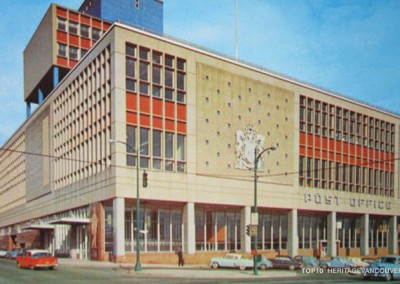

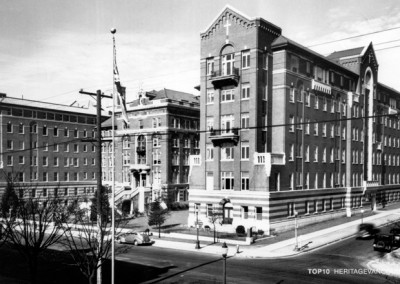
![4. Schools: Sir James Douglas Elementary (1910-12) [lost]](https://heritagevancouver.org/wp-content/uploads/2012/08/t10-school-douglas-795-400x284.jpg)
